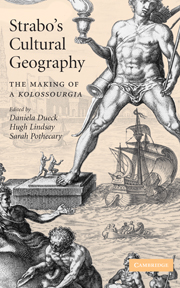Book contents
- Frontmatter
- Contents
- List of maps
- List of illustrations
- List of tables
- List of figures
- List of contributors
- Acknowledgements
- List of abbreviations
- Introduction
- 1 Kolossourgia. ‘A colossal statue of a work’
- 2 Reflections of philosophy: Strabo and geographical sources
- 3 Who is a barbarian? The barbarians in the ethnological and cultural taxonomies of Strabo
- 4 Gender at the crossroads of empire: locating women in Strabo's Geography
- 5 Strabo and Homer: a chapter in cultural history
- 6 Strabo's use of poetry
- 7 Strabo's sources in the light of a tale
- 8 The foundation of Greek colonies and their main features in Strabo: a portrayal lacking homogeneity?
- 9 Ανδρες ἔνδοξοι or ‘men of high reputation’ in Strabo's Geography
- 10 Comparing Strabo with Pausanias: Greece in context vs. Greece in depth
- 11 The European provinces: Strabo as evidence
- 12 Amasya and Strabo's patria in Pontus
- 13 Cappadocia through Strabo's eyes
- 14 Greek geography and Roman empire: the transformation of tradition in Strabo's Euxine
- 15 Josephus' hidden dialogue with Strabo
- 16 Temporal layers within Strabo's description of Coele Syria, Phoenicia and Judaea
- Bibliography
- Index of geographical names
- Index of personal names
8 - The foundation of Greek colonies and their main features in Strabo: a portrayal lacking homogeneity?
Published online by Cambridge University Press: 18 December 2009
- Frontmatter
- Contents
- List of maps
- List of illustrations
- List of tables
- List of figures
- List of contributors
- Acknowledgements
- List of abbreviations
- Introduction
- 1 Kolossourgia. ‘A colossal statue of a work’
- 2 Reflections of philosophy: Strabo and geographical sources
- 3 Who is a barbarian? The barbarians in the ethnological and cultural taxonomies of Strabo
- 4 Gender at the crossroads of empire: locating women in Strabo's Geography
- 5 Strabo and Homer: a chapter in cultural history
- 6 Strabo's use of poetry
- 7 Strabo's sources in the light of a tale
- 8 The foundation of Greek colonies and their main features in Strabo: a portrayal lacking homogeneity?
- 9 Ανδρες ἔνδοξοι or ‘men of high reputation’ in Strabo's Geography
- 10 Comparing Strabo with Pausanias: Greece in context vs. Greece in depth
- 11 The European provinces: Strabo as evidence
- 12 Amasya and Strabo's patria in Pontus
- 13 Cappadocia through Strabo's eyes
- 14 Greek geography and Roman empire: the transformation of tradition in Strabo's Euxine
- 15 Josephus' hidden dialogue with Strabo
- 16 Temporal layers within Strabo's description of Coele Syria, Phoenicia and Judaea
- Bibliography
- Index of geographical names
- Index of personal names
Summary
The Roman world of the first century bce, which provides not only the historical and political but also the cultural and ideological context of Strabo's work, is perceived and consequently described in the Geography as a complex overall picture to which all the qualities and methodological knowledge peculiar to the philosopher must be applied. Within this picture, individual details may be played down or omitted if they risk diverting the reader's attention away from the overall view. This is the underlying theme of the famous chapters 22 and 23 of the first book of the Geography. Strabo's attitude towards elements of the Greek political and historical tradition that survive in the culture of the Augustan era should also be understood in this sense.
When we speak of historical and political tradition, there are probably few things more ‘Greek’ than a Greek colony, than an ἀποικία; and when we speak of Greek colonisation, nobody can overestimate Strabo's importance as a source, for we must thank him for a considerable number of fragments relating to colonial undertakings which were taken from both Greek and non-Greek authors.
The purpose of this contribution is to read the Strabonian account of Greek colonisation as part of his general view of the Augustan world and as an entirely consistent component in his concept of a geographical work as it is outlined in the opening chapters.
There he focuses on methodology and on the training not only of the geographer, but also of his reader.
- Type
- Chapter
- Information
- Strabo's Cultural GeographyThe Making of a Kolossourgia, pp. 118 - 128Publisher: Cambridge University PressPrint publication year: 2005

